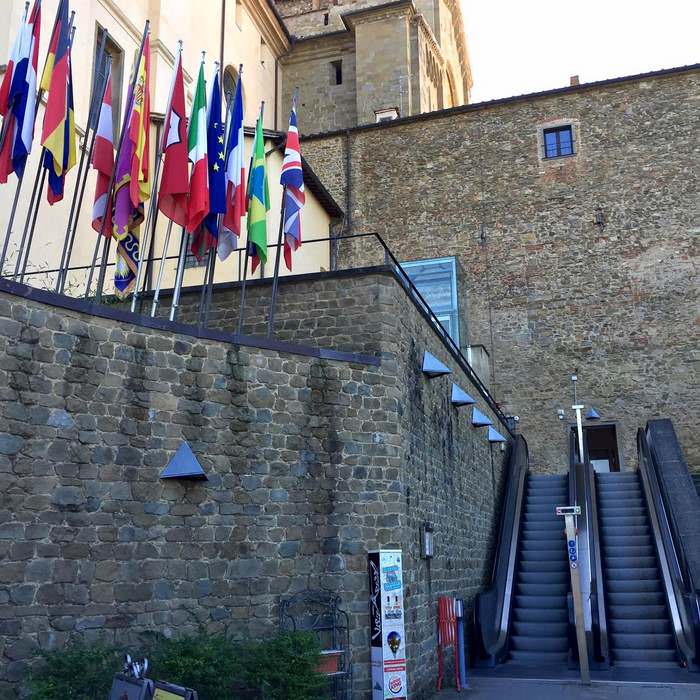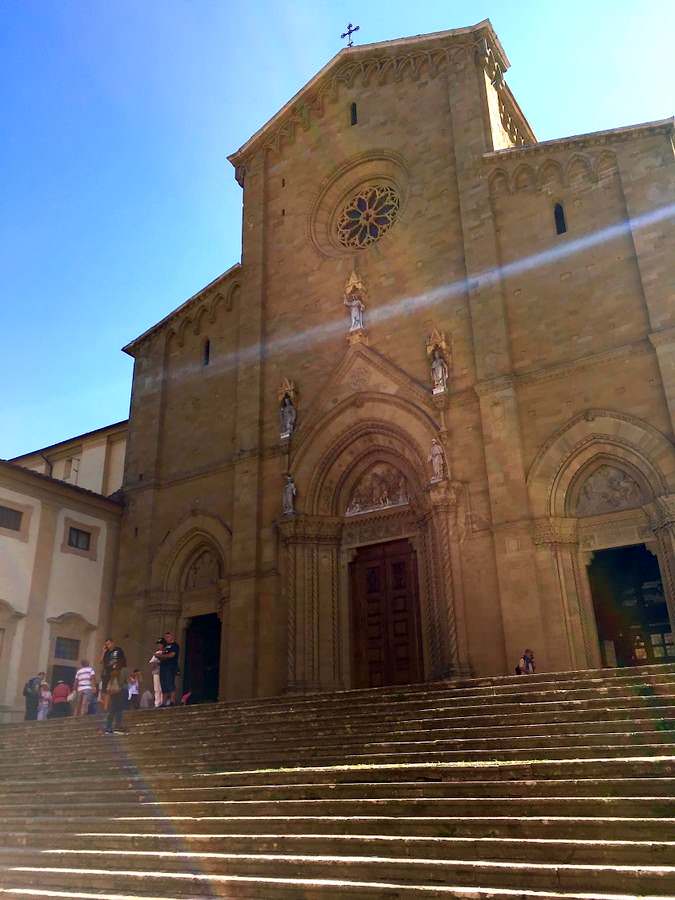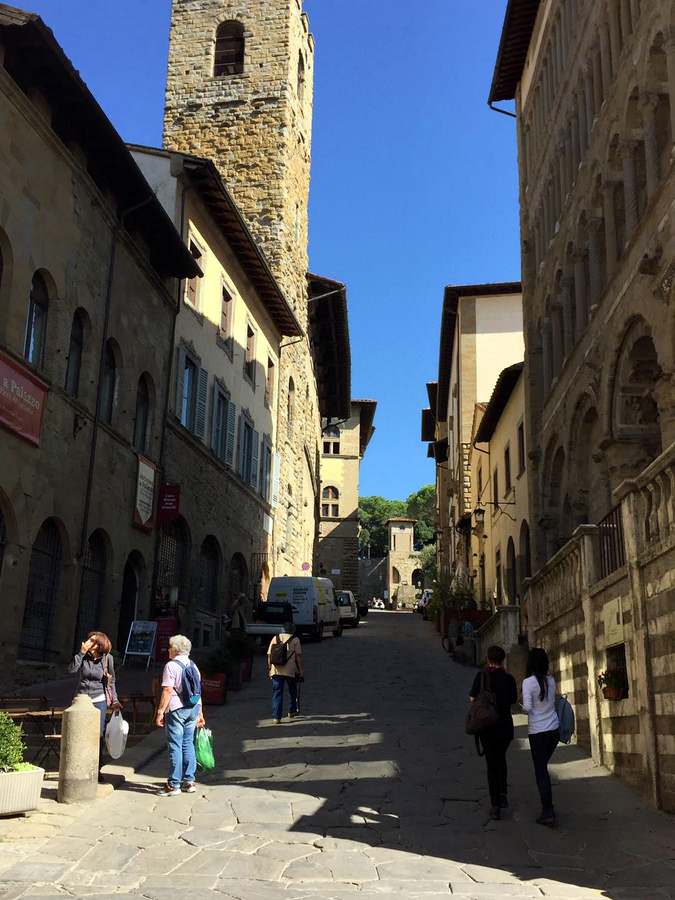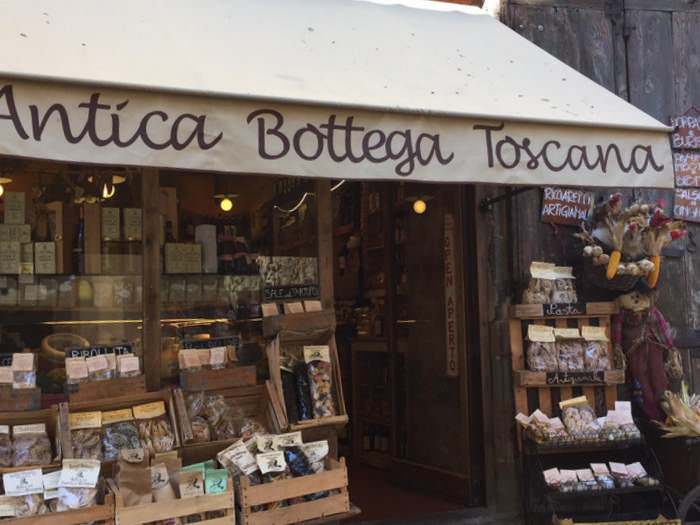Arezzo’s current population of 100,000 is many tines what it was during Etruscan and, later, Roman rule, but the city has remained a commercial and cultural center for millennia. One of the hallmarks of Etruscan civilization – the working of gold to produce fine filigree jewelry – has continued to the present day: Arezzo is one of Italy’s three recognized gold districts (the others are Vicenza in Veneto and Valenza in Piedmont). Arezzo produced up to one-third of all Italy’s gold jewelry until recently, when the industry was hit by the high cost of gold and the low cost of Chinese and Indian competitors. It is still a major manufacturer, however, and its annual trade show, Oroarezzo, is one of the top gatherings for the gold industry globally. (Note: try to avoid visiting Arezzo during this event).

Arezzo’s city walls date to Etruscan times, but what we see is more medieval than-pre-Roman
Glittering Arezzo
There are more than 1,200 gold jewelry manufacturers here, but the best examples of fine, gold jewelry are to be found in the Archeological Museum (Museo Archeologico Gaio Cilnio Mecenate). Glittering examples of Etruscan gold-working artistry are on display; especially noteworthy are items of jewelry discovered in the nearby Poggio del Sole necropolis. Some of the designs feel so contemporary that you could wear them to the opera without feeling out of place.

The entrance to the old city of Arezzo is by stairs or escalator
The Archeological Museum is located in the ex-monastery of St. Bernardo, which in turn was built on the remains of an ancient Roman amphitheater from the early second century AD. You can see ruins suggesting the once-imposing 13,000-seat amphitheater outside, and some elements have been integrated into the museum itself during its latest renovation. You will also find the world’s largest collection of vasi coralline (table vases) from first century BC to first century AD, which is testimony to the Etruscans’ outstanding skill in ceramics.
Sadly, the Etruscan presence in Arezzo is visible only here and in bits of the city wall and the archeological zone of Castelsecco-San Cornelio on the outskirts of the city. The rest was destroyed or carried off in the wake of invasions by the Lombards, the Florentines, the French, and (in World War II) the Germans. One of the saddest examples of plundered Etruscan artistry is the “Chimera of Arezzo”, a bronze status from around 400 BC. It was discovered in Arezzo in 1553 but was taken by those insatiable Medici to Florence, where it is currently on display in that city’s Archeological Museum.

Renaissance coats of arms can be seen on major buildings from that period
A short distance from the Museo Mecenate, just past the escalator or the MANY steps by which you are likely to have entered Arezzo from Via Giuseppe Petri, is the Cathedral of Arezzo. It is also known as the Cattedrale di Ss. Donato e Pietro, for the city’s patron saint, and boasts magnificent stained glass windows, the tomb of Pope Gregory X, a baptismal font with a relief by Donatello, terracottas by Andrea della Robbia, and a fresco by Piero della Francesca. (What it doesn’t have are the actual relics of Saint Donatus, which reside in a church in Teramo, Abruzzo). An architect or art historian can point out the various phases of development of this structure, begun in 1278 and completed more than six hundred years later in 1914.

The cathedral of Arezzo, is dedicated to St. Donato and is rich with Renaissance artwork
Piazza Grande is the cultural heart of Arezzo. Its spacious trapezoidal shape encompasses an architectural jumble of medieval, Gothic, and Renaissance styles from the 13th to the 16th century. Each tower, church, colonnade, and palace has a story to tell; a guide is advised who can take you through the history of the city through its buildings and other structures. Some of them may look familiar; Roberto Benigni used Piazza Grande in scenes for his Oscar-winning film, La Vita è Bella (Life is Beautiful).

A partial view of the splendid piazza Grande of Arezzo
A more visceral way to live this city’s landmarks, at least through its medieval period, is to visit on the next-to-last Saturday in June or the first Sunday of September, when the Giostra del Saraceno is re-enacted in Piazza Grande. This is a competition among riders from the city’s four quartieri to charge – on horseback — a mannequin posted at one end of the piazza. The riders have lances, the mannequin a shield, and the idea is to strike the latter in the most vulnerable spot. The quartiere amassing the greatest number of points wins. Origins of the competition date back to the 1500s; Dante wrote about it in The Inferno. Hundreds of locals dressed as nobles, musicians, knights, flag carriers, artisans, and acrobats crowd the streets, along with dozens of horses and thousands of visitors. The June version is held at night, the September event is during the day, but the rest is the same – a genuinely local festival, full of joy and color, not tainted by the cruelty to horses that mars the better-known Palio di Siena.

The old town of Arezzo has a decidedly medieval feel
The piazza also hosts the Fiera Antiquaria (Antique Fair) on the first weekend of every month, drawing thousands of visitors from through out Italy. It’s the oldest antique fair of its kind in Italy and the largest: between 400-500 exhibitors display furniture, books, objets d’art, musical and scientific instruments, jewels and costume jewelry, as well as collectible items of all kinds. If you happen to miss the fair, don’t worry: Arezzo boasts more than 100 antique stores, so you can still browse regardless of your timing.

No big department stores in the old town of Arezzo, but lots of specialty shops
Not into browsing? or jousting? Arezzo’s outstanding attractions include the Leggenda della Vera Croce (Legend of the True Cross), a series of frescoes painted by Piero della Francesca in the Cappella Bacci (Bacci Chapel) of the Basilica di San Francesco between 1458-1466. The theme is loosely the story of the cross on which Jesus was crucified, including the tree from which it was made. The artist interwove events and personalities from this era into the imagery, and a capable guide will take you through them, enriching the vivid artwork and expanding your knowledge of history. Visitors enter in 30-minute intervals to avoid crowding; reservations are mandatory.

One of the dazzling frescoes by Piero della Francesca that decorate the Bacci Chapel
Undervalued by international tourism, Arezzo has much to offer the Tuscany-loving traveler, and it doesn’t have to depend on the gold industry for its glitter.
Written by and photos by Claudia Flisi for EuropeUpClose.com
###
